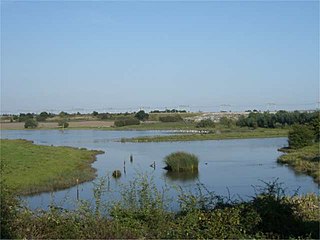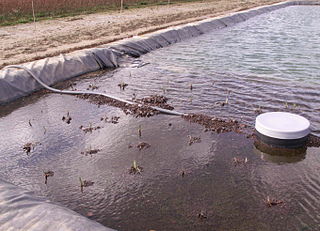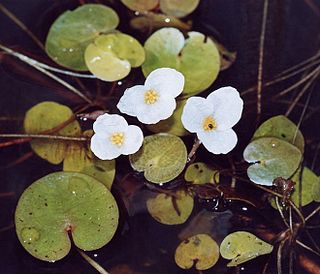
Aquatic plants are plants that have adapted to living in aquatic environments. They are also referred to as hydrophytes or macrophytes to distinguish them from algae and other microphytes. A macrophyte is a plant that grows in or near water and is either emergent, submergent, or floating. In lakes and rivers macrophytes provide cover for fish, substrate for aquatic invertebrates, produce oxygen, and act as food for some fish and wildlife.

Water garden or aquatic garden, is a term sometimes used for gardens, or parts of gardens, where any type of water feature is a principal or dominant element. The primary focus is on plants, but they will sometimes also house waterfowl, or ornamental fish, in which case it may be called a fish pond. They vary enormously in size and style.

Sandbach Flashes are a group of 14 wetlands west of Sandbach in Cheshire, England. The flashes were designated as a Site of Special Scientific Interest in 1963, with a total area of 1.53 km2. There are a number of individual flashes including Bottom's Flash, Crabmill Flash, Elton Hall Flash, Fodens Flash, Groby's Flash, Ilse Pool, Moston Flashes, Pump House Flash, Railway Flash, Red Lane Tip and Pool, and Watch Lane Flash.
The Potamogeton natans community is one of the aquatic communities in the British National Vegetation Classification system.

A hydrosere is a plant succession which occurs in an area of fresh water such as in oxbow lakes and kettle lakes. In time, an area of open freshwater will naturally dry out, ultimately becoming woodland. During this change, a range of different landtypes such as swamp and marsh will succeed each other.

Biddle Street, Yatton is a 44.8 hectare biological Site of Special Scientific Interest (SSSI) near the village of Yatton in North Somerset, notified in 1994.

A lava filter is a biological filter that uses lavastone pebbles as support material on which microorganisms can grow in a thin biofilm. This community of microorganisms, known as the periphyton break down the odor components in the air, such as hydrogen sulfide. The biodegradation processes that occurs is provided by the bacteria themselves. In order for this to work, sufficient oxygen as well as water and nutrients is to be supplied.

Most organisms involved in water purification originate from the waste, wastewater or water stream itself or arrive as resting spore of some form from the atmosphere. In a very few cases, mostly associated with constructed wetlands, specific organisms are planted to maximise the efficiency of the process.

Hydrocharis morsus-ranae, frogbit, is a flowering plant belonging to the genus Hydrocharis in the family Hydrocharitaceae. In North America, it is referred to as common frogbit or European frog's-bit to distinguish it from the related American frogbit.

Potamogeton polygonifolius or bog pondweed, is an aquatic plant. It is found in shallow, nutrient-poor, usually acid standing or running water, bogs, fens and occasionally ditches.

Potamogeton coloratus, the fen pondweed, is an aquatic plant in the genus Potamogeton. It is found in shallow peaty calcareous lakes, ponds and ditches, commonly associated with lowland fens.

Potamogeton epihydrus is a perennial aquatic plant known by the common names ribbonleaf pondweed and Nuttall's pondweed, and American pondweed in the United Kingdom. It is native to much of North America, where it grows in water bodies such as ponds, lakes, ditches, and slow-moving streams.

Potamogeton gramineus is a species of aquatic plant known by the common name various-leaved pondweed, variableleaf pondweed, grass-leaved pondweed or grassy pondweed, native to the northern hemisphere where it grows in shallow, clean water.

Potamogeton pusillus is a species of aquatic plant known by the common names small pondweed, lesser pondweed or least pondweed. It occurs in standing and slow-flowing freshwater habitats throughout the Northern Hemisphere.

Potamogeton obtusifolius, known as blunt-leaved pondweed, is an aquatic plant in the genus Potamogeton. It grows mainly in mesotrophic to eutrophic lakes, ponds and ditches, rarely in brackish water. It occurs primarily in Central Europe, the British Isles, Fennoscandia and eastern North America.
Cehei Pond Nature Reserve is situated in north-western Romania, in Crasna river floodplain, in Sălaj County and is a protected area with aquatic vegetation and fauna specific to such area.

Potamogeton trichoides is a species of aquatic plant known by the common name hairlike pondweed, native to Europe and western Asia where it grows in calcareous, usually nutrient-rich standing or slow-flowing water.